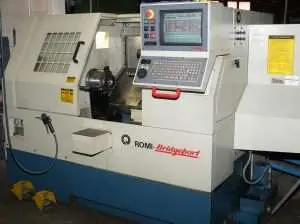What is a CNC machine?
 A CNC machine is a computer-controlled manufacturing cell that has several moving axes (Usually 2-5). The most common are milling and turning machines, But CNC can also refer to grinders, laser cutting machines, and 3D printing machines.
A CNC machine is a computer-controlled manufacturing cell that has several moving axes (Usually 2-5). The most common are milling and turning machines, But CNC can also refer to grinders, laser cutting machines, and 3D printing machines.
Brief History of CNC Machines
Automatic machining in milling and turning operations had existed long before the CNC concept was introduced. These earlier generation machines used a set of cams rotating on a shaft that synchronized the movement between the machine’s axes to produce a specific part. One of the major drawbacks was that every new part, or a modification of a parts drawing had required to reproduce a new set of cams.
CNC stands for Computerized Numerical Control. In 1952, Richard Kegg, in collaboration with MIT, developed the first CNC milling machine. In 1958, he filed a patent for a “Motor Controlled Apparatus for Positioning Machine Tool”. A paper tape fed the instructions into the machine. The Gcode language was developed to create programs for the machines and was standardized in the form we know today in the 1960’s. Since then, CNC is continuously evolving, moving from punch tapes to dedicated electronic controllers and is the past two decades into personal computers.
CNC machines back then and now
The basic CNC machines that were developed and manufactured based on the new concept were 3 axis milling machines and 2 axis lathe machines. Over the past decades, CNC machines had evolved and improved in several areas:
- The number of axes: Milling machines got 4th axes, typically a rotation of the workpiece, and later the 5th axis typically a tilting of the workpiece. It enabled machining more complicated parts and manufacturing simple parts in “one clamping”, instead of several clamps. Some modern CNC machines (Mainly CNC grinders) can have 7 axes or even more.
- Rapid Traverse Speed: The axes’ speed while not machining greatly affects the cycle time by minimizing tool change and workpiece change durations. Year over year, this parameter gradually goes up.
- Spindle speed: The maximum RPM of the spindle also developed from a maximum of no more than several hundred in the 1960s to tens of thousands of RPM today. It dramatically improved the cycle times in milling over the years.
- Accuracy: This is a critical factor in high-end machines. Constant improvement in mechanical bearings and servo controllers enables machining today very accurate parts that were impossible to make in the past.
- More manufacturing technologies: In the beginning, only milling and turning machines adapted the new technology. Gradually all the manufacturing technologies adapted the concept of controlled axes: grinding machines, Sheet Metal, Laser cutting, and the hottest trend in recent years – the 3D printers.
- Hybrid technologies – Until the 1980s, a milling machine was a milling machine, and a lathe was a lathe. Gradually manufacturers developed manufacturing cells that integrated several manufacturing technologies into one machine, thus increasing the flexibility of parts the machine can make and enabling to finish parts in a “one clamping”. The most common integration is lathe machines with milling capabilities, but there are also many more combinations on the market.









